.
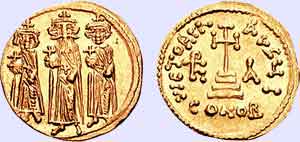
Heraclius and his sons Heraclius Constantine and Heraclonas. [Source]
Flavius Heraclius Augustus ( Ηράκλειος)(c. 575 - February 11, 641) was Byzantine Emperor from October 5, 610 to February 11, 641.
Origins
Heraclius' family was almost certainly of Armenian[1] origins, though beyond that there is little specific information known about his ancestry. He was the son and namesake of Heraclius (generally referred to retroactively as "Heraclius the Elder"), who had been one of Emperor Maurice's key generals in the 590 war with Persia. After the war, Maurice appointed Heraclius the Elder to the position of Exarch of Africa. Though the younger Heraclius' birthplace is unknown, he grew up in Roman Africa; according to one tradition, he engaged in gladiatorial combat with lions as a youth.
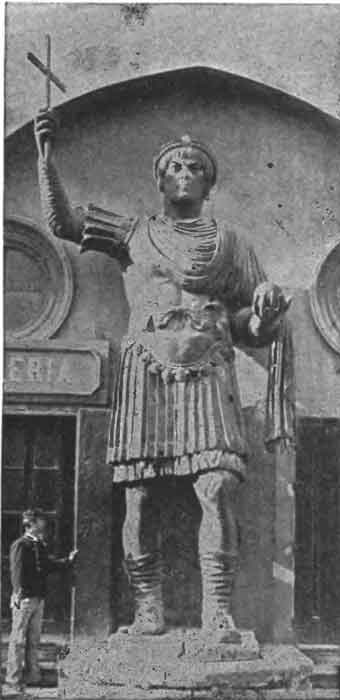
Heraclius
The revolt against Phocas and the accession of Heraclius
In 608, the Heraclius the Elder renounced his loyalty to the Emperor Phocas, who had overthrown Maurice six years earlier. The rebels issued coins showing both Heraclii dressed as consuls, though neither of them explicitly claimed the imperial title at this time. The younger Heraclius' cousin Nicetas launched an overland invasion of Egypt; by 609, he had defeated Phocas's general Bonosus and secured the province. Meanwhile, the younger Heraclius sailed eastward with another force via Sicily and Cyprus. As he approached Constantinople, he made contact with leading aristocrats in the city, and soon arranged a ceremony where he was crowned and acclaimed as emperor. When he reached the capital, the Excubitors, an elite imperial guard unit led by Phocas's own son-in-law Priscus, deserted to Heraclius, and he entered the city without serious resistance. Heraclius personally executed Phocas. On October 5, 610, Heraclius was crowned for a second time, this time in the Chapel of St. Stephen within the Great Palace, and at the same time wed his betrothed, Fabia, who took the name Eudocia. She was beloved in Constantinople, and when she died in 612 and he married his niece Martina, the second marriage was never approved of. In the reign of Heraclius' two sons, the divisive Martina was to become the center of power and political intrigue.
The war against Persia
When Heraclius took power, the Empire was in a desperate situation. Phocas's initial revolt had stripped the Danube frontier of troops, leaving the most of the Balkans at the mercy of the Avars. The Persian King Chosroes II, who had been an ally of Maurice, used his death as an excuse to launch a war against the Byzantines. Chosroes had at his court a man who claimed to be Maurice's son Theodosius, and Chosroes demanded that the Byzantines accept him as Emperor. The Persians had slowly gained the upper hand in Mesopotamia over the course of Phocas's reign; when Heraclius' revolt resulted in civil war, the Persians took advantage of the internal conflict to advance deep into Syria.
Heraclius offered peace terms to the Persians upon his accession, but Khosrau refused to treat with him, viewing him as just another usurper of Theodosius' throne. Heraclius' initial military moves against the Persians ended disastrously, and the Persians rapidly advanced westward. They took Damascus in 613, Jerusalem in 614 (damaging the Church of the Holy Sepulchre and capturing the Holy Cross in the process), and Egypt in 616. They made raids deep into Anatolia as far as Chalcedon, a town lying almost opposite of Constantinople across the Bosporous. At night, it was said, the people of Constantinople would see Persian watch-fires and their reflection on the water. The Persians were also in communication with the Avars.
The situation was so grave that Heraclius reportedly considered moving the capital from Constantinople to Carthage. But he remained in the East and worked on reorganizing the Byzantine military. He developed the idea of granting land to individuals in return for hereditary military service. The land so granted was organised into thema, a Greek word to describe a division of troops, and each theme was placed under the command of a strategos or military governor. This arrangement ensured the continuance of the Empire for hundreds of years and enabled Heraclius to reconquer lands taken by the Persians, ravaging Persia along the way.
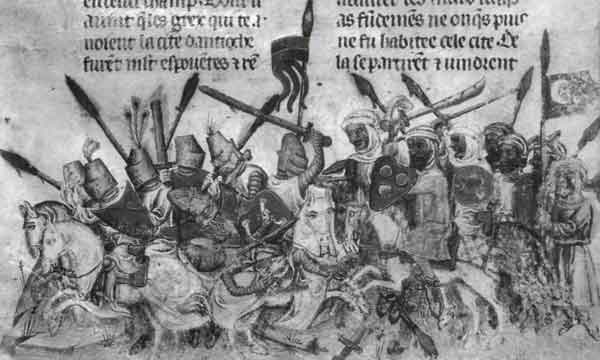
Battle of Antiochia
Once he had rebuilt the army, Heraclius took the field himself in 621, the first emperor to campaign against a foreign enemy in person since Theodosius I. Confident that Constantinople was well defended, and unwilling to engage in a war of attrition over the lost eastern provinces, he marched across Asia Minor and invaded Persia itself. He would stay on campaign for several years. In 626, Constantinople itself was besieged by the Avars; but Persian attempts to cross the Bosporus and aid the Avars were repulsed by the Byzantine navy, and the Avars withdrew. Meanwhile, Heraclius acquired the assistance of the Khazars and other Turkic troops. Heraclius also exploited divisions within the Persian Empire, keeping the great Persian general Shahrbaraz neutral by convincing him that Chosroes had grown jealous of him and ordered his execution. At the Battle of Nineveh in 627, the Roman forces (without the Khazars who left Heraclius) defeated the Persians under Rhazates. In 629 he allied with the Ethiopians and began to re-win provinces he had lost to Persia. The Ethiopians put tremendous military pressure on the Persians whose armies were no match for the fast moving Ethiopians, who were more than happy to crush Persia for an earlier invasion of the Arabian peninsula that was Ethiopian controlled. When Chosroes still refused to make peace, Heraclius continued his campaign; as he approached the Persian capital of Ctesiphon, the Persian aristocracy deposed Chosroes. His successor made peace with Heraclius by restoring all the empire's former territories. The Persian Sassanid dynasty never recovered from this war; it took years for a strong king to emerge from a series of coups, and soon the Arabs overwhelmed the sinking state.
Heraclius took for himself the ancient Persian title of "King of Kings", dropping the traditional Roman imperial title of "Augustus". Later on, he styled himself as Basileus, the Greek word for "King", and that title was used by the eastern Roman emperors for the next 800 years. Heraclius also discontinued the use of Latin as the empire's official language, replacing it with Greek. Although the empire called itself Roman throughout the rest of its history, it was in reality a Hellenic empire from Heraclius onward.
In 630, he reached the height of his power when he marched barefoot as a pious christian pilgrim carrying the true cross, triumphantly into Jerusalem and restored it, the True Cross to the Church of the Holy Sepulchre.
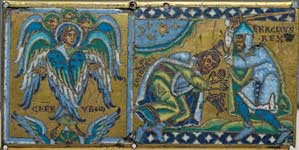
Cherub and Byzantine Emperor Heraclius submitting Sassanid king Khosrau II
The war against the Arabs
Unfortunately for Heraclius' war-weary empire, and unknown to him at the time, Muhammad had only recently succeeded in unifying all the nomadic tribes of the Arabian Peninsula. The Arabs, who had been too divided in the past to pose a military threat, now comprised one of the most powerful states in the region, and were animated by their new conversion to Muhammad's religion of Islam.
Heraclius fell ill soon after his triumph over the Persians and never took the field again. When the Arab Muslims invaded Syria and Palestine in 634, he was unable to oppose them personally, and his generals failed him. The Battle of Yarmuk in 636 resulted in a crushing defeat for the larger Roman army and within three years, Syria and Palestine were lost again. By the time of Heraclius' death, most of Egypt had fallen as well.
Legacy
Although his defeat of the Persians produced no lasting benefit to the empire, Heraclius still ranks among the greatest of the Byzantine emperors. His reforms of the government reduced the corruption which had taken hold in the disastrous reign of Phocas, and he reorganized the military with great success. Ultimately, the reformed imperial army halted the Muslims in Asia Minor and held on to Carthage for another 60 years, saving a core from which the empire's strength could be rebuilt.
The recovery of the eastern areas of the Byzantine Empire from the Persians once again raised the problem of religious unity centering around the understanding of the true nature of Christ. Most of the inhabitants of these provinces were Monophysites who rejected the Council of Chalcedon. Heraclius tried to promote a compromise doctrine called Monothelitism; however, this philosophy was rejected as heretical by both sides of the dispute. For this reason, Heraclius was viewed as a heretic and bad ruler by some later religious writers. After the Monophysite provinces were finally lost to the Muslims, Monotheletism rather lost its raison d'être and was eventually abandoned.
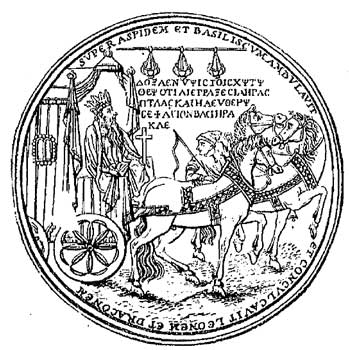
Heraclius defeat of the Persians
Heraclius and Fabia-Eudocia had two children:
- Epiphania-Eudocia, Augusta
- Heraclius Constantine, Emperor 641
With his second wife Martina, the Emperor had at least ten children, though the names and order of these children are questions for debate:
- Fabius, had a paralysed neck
- Theodosius, was a deaf-mute, married Nike, daughter of Persian general Shahrbaraz
- Constantine
- Heraclius II (Heracleonas), Emperor 638 - 641
- David (Tiberius), proclaimed Caesar in 638
- Martinus or Marinus
- Augustina, Augusta
- Anastasia and/or Martina, Augusta
- Febronia
Of these at least two were handicapped, which was seen as punishment for the illegality of the marriage.
He also had at least one illegitimate son, Atalarichus, who was mutiliated and exiled to Prinkipo in 637 for his involvement in the plot against Heraclius.
During the last years of Heraclius' life, it became evident that a struggle was taking place between Heraclius Constantine and Martina who was trying to position her son Heracleonas in line for the throne. When Heraclius died, in his will he left the empire to both Heraclius Constantine and Heracleonas to rule jointly with Martina as Empress and mother of both.
Note
- ↑ Theophylact Simocatta, 109-110
Links
De Imperatoribus Romanis: an online encyclopedia of Roman Emperors
Preceded by: Phocas
Byzantine Emperor
Succeeded by: Constantine III
| Ancient Greece
Science, Technology , Medicine , Warfare, , Biographies , Life , Cities/Places/Maps , Arts , Literature , Philosophy ,Olympics, Mythology , History , Images Medieval Greece / Byzantine Empire Science, Technology, Arts, , Warfare , Literature, Biographies, Icons, History Modern Greece Cities, Islands, Regions, Fauna/Flora ,Biographies , History , Warfare, Science/Technology, Literature, Music , Arts , Film/Actors , Sport , Fashion --- |
Retrieved from "http://en.wikipedia.org"
All text is available under the terms of the GNU Free Documentation License

